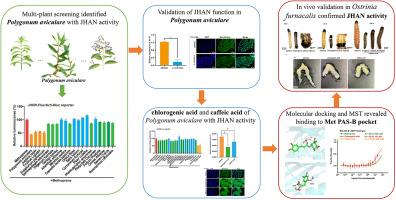Mechanistic insights into chlorogenic acid and caffeic acid as novel juvenile hormone antagonists
IF 4
1区 农林科学
Q2 BIOCHEMISTRY & MOLECULAR BIOLOGY
引用次数: 0
Abstract
The search for eco-friendly alternatives to conventional chemical insecticides has intensified due to environmental concerns and pest resistance. Juvenile hormone antagonists (JHANs), which disrupt insect development and reproduction with minimal toxicity to vertebrates, offer a promising avenue for sustainable pest management. In this study, a preliminary screening using a juvenile hormone response region (JHRR)-driven luciferase reporter assay in Drosophila Kc cells found that Polygonum aviculare extract exhibited notable JHAN activity among crude extracts from various plants tested. Guided by literature-reported constituents of P. aviculare, we further identified chlorogenic acid and caffeic acid as potent JHANs. Both compounds inhibited Methoprene-induced JHRR activity and disrupted the interaction between the JH receptor Methoprene-tolerant (Met) and its coactivator Taiman (Tai) in a dose-dependent manner. Mechanistic studies demonstrated that chlorogenic acid and caffeic acid possibly compete with Methoprene for binding to the PAS-B domain of Met, preventing the Methoprene-stimulated association of Met with the chaperone protein Hsp83. This inhibition, in turn, blocks the nuclear translocation of Met and downstream Kr-h1 expression. In vivo assays demonstrated that chlorogenic acid or caffeic acid treatment induced precocious metamorphosis in Ostrinia furnacalis larvae and suppressed ovarian development in adults, mimicking JH depletion. These findings highlight the potential of P. aviculare extracts as a sustainable source of JHANs for integrated pest management, offering a novel mechanism-based approach to reduce reliance on synthetic insecticides.

绿原酸和咖啡酸作为新型幼年激素拮抗剂的机理研究
由于对环境的关注和对害虫的抵抗力,寻找传统化学杀虫剂的生态友好替代品的工作已经加强。幼虫激素拮抗剂(JHANs)对脊椎动物的毒性最小,可破坏昆虫的发育和繁殖,为可持续害虫管理提供了一条有前途的途径。本研究在果蝇Kc细胞中使用JHRR驱动的荧光素酶报告试验进行初步筛选,发现在不同植物的粗提取物中,蓼提取物具有显著的JHAN活性。根据文献报道的成分,我们进一步确定了绿原酸和咖啡酸是有效的j汉斯。这两种化合物均能抑制甲氧丁烯诱导的JHRR活性,并以剂量依赖性的方式破坏JH受体甲氧丁烯耐受性(methoprene - tolerance, Met)与其共激活物Taiman (co - activator, Tai)之间的相互作用。机制研究表明,绿原酸和咖啡酸可能与Methoprene竞争Met的PAS-B结构域,阻止Methoprene刺激的Met与伴侣蛋白Hsp83结合。这种抑制反过来阻断Met的核易位和下游的Kr-h1表达。体内实验表明,绿原酸或咖啡酸处理可诱导玉米螟幼虫早熟变态,并抑制成虫卵巢发育,类似JH耗竭。这些发现强调了木耳提取物作为综合虫害管理中JHANs可持续来源的潜力,为减少对合成杀虫剂的依赖提供了一种基于机制的新方法。
本文章由计算机程序翻译,如有差异,请以英文原文为准。
求助全文
约1分钟内获得全文
求助全文
来源期刊
CiteScore
7.00
自引率
8.50%
发文量
238
审稿时长
4.2 months
期刊介绍:
Pesticide Biochemistry and Physiology publishes original scientific articles pertaining to the mode of action of plant protection agents such as insecticides, fungicides, herbicides, and similar compounds, including nonlethal pest control agents, biosynthesis of pheromones, hormones, and plant resistance agents. Manuscripts may include a biochemical, physiological, or molecular study for an understanding of comparative toxicology or selective toxicity of both target and nontarget organisms. Particular interest will be given to studies on the molecular biology of pest control, toxicology, and pesticide resistance.
Research Areas Emphasized Include the Biochemistry and Physiology of:
• Comparative toxicity
• Mode of action
• Pathophysiology
• Plant growth regulators
• Resistance
• Other effects of pesticides on both parasites and hosts.

 求助内容:
求助内容: 应助结果提醒方式:
应助结果提醒方式:


